Research Design: Impact of Socioemotional Wealth on Governance
VerifiedAdded on 2023/01/12
|20
|8222
|46
Report
AI Summary
This research design explores the impact of socioemotional wealth (SEW), specifically the 'binding social ties' dimension, on corporate governance within Saudi Arabian family firms. The study aims to understand how these ties influence board independence and the succession of non-family CEOs. Employing an interpretivist stance, the research will initially use a qualitative, multi-case study approach with structured interviews, followed by a quantitative survey to triangulate findings and enhance validity. The research focuses on large family firms operating in Saudi Arabia, identifying key stakeholders such as non-family employees and executives. The ultimate goal is to contribute to the body of knowledge concerning SEW's impact on corporate governance in the unique cultural context of Saudi Arabia, addressing the research questions related to board independence and CEO succession.
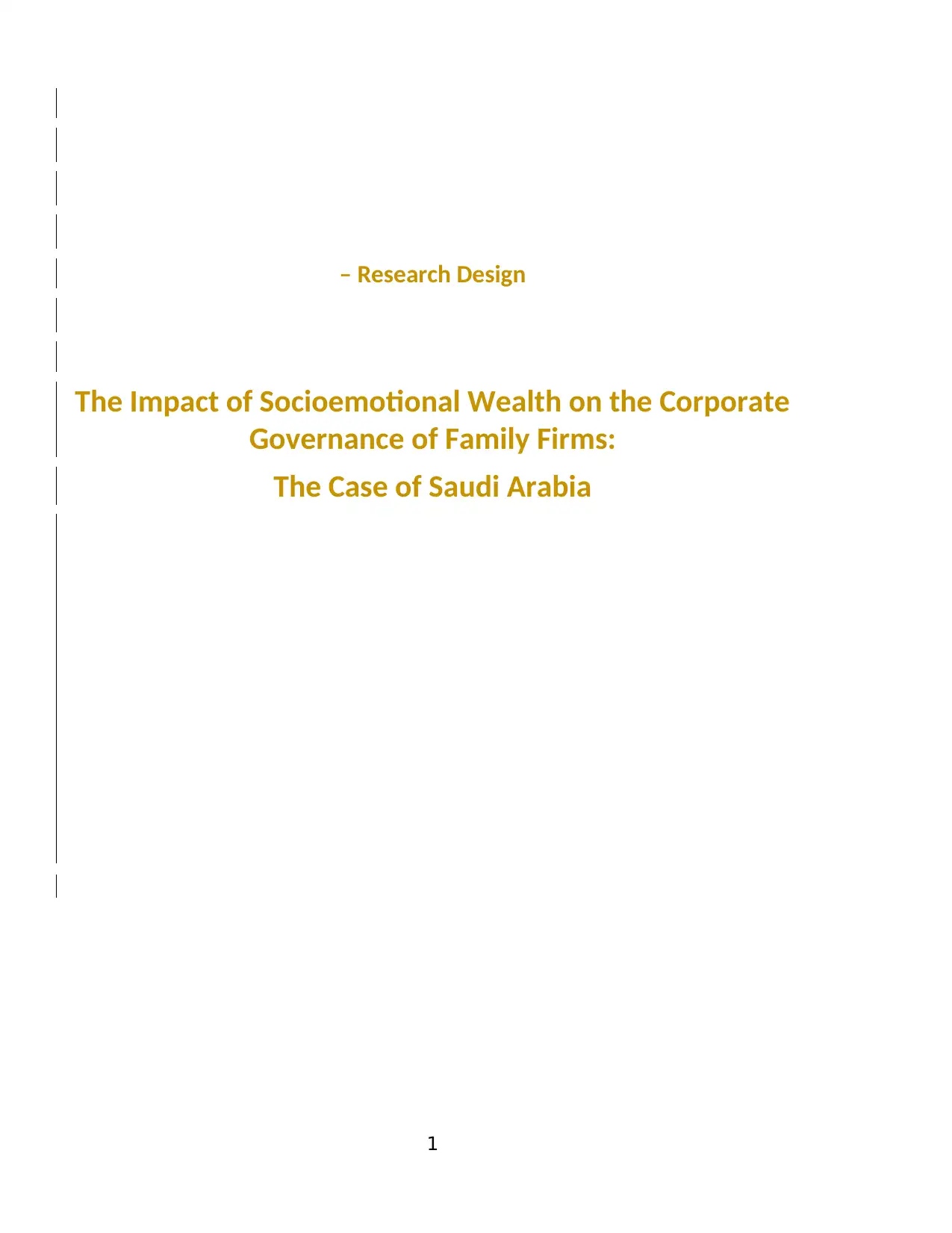
– Research Design
The Impact of Socioemotional Wealth on the Corporate
Governance of Family Firms:
The Case of Saudi Arabia
1
The Impact of Socioemotional Wealth on the Corporate
Governance of Family Firms:
The Case of Saudi Arabia
1
Paraphrase This Document
Need a fresh take? Get an instant paraphrase of this document with our AI Paraphraser
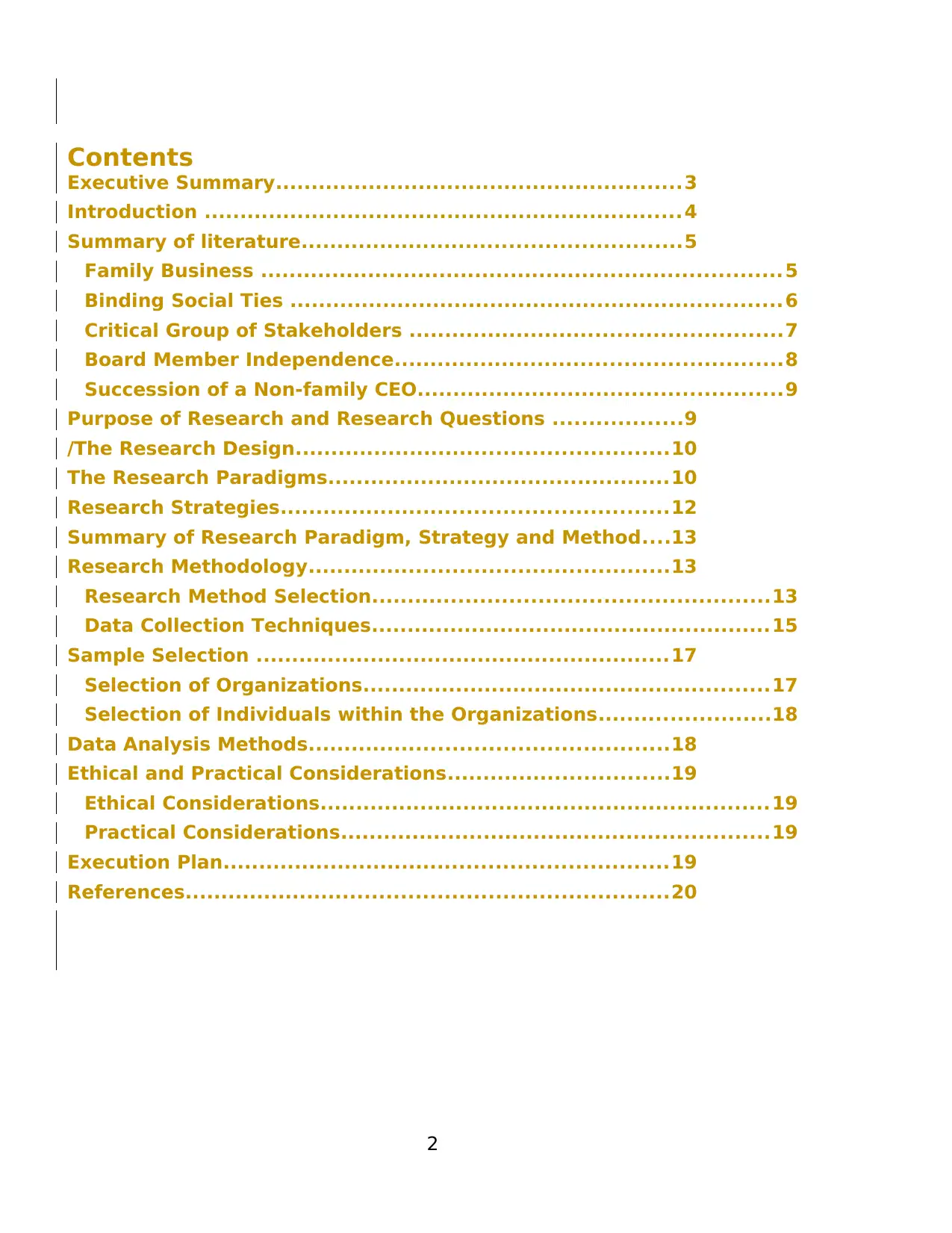
Contents
Executive Summary.........................................................3
Introduction ...................................................................4
Summary of literature.....................................................5
Family Business .........................................................................5
Binding Social Ties .....................................................................6
Critical Group of Stakeholders ....................................................7
Board Member Independence......................................................8
Succession of a Non-family CEO...................................................9
Purpose of Research and Research Questions ..................9
/The Research Design....................................................10
The Research Paradigms................................................10
Research Strategies......................................................12
Summary of Research Paradigm, Strategy and Method....13
Research Methodology..................................................13
Research Method Selection.......................................................13
Data Collection Techniques........................................................15
Sample Selection ..........................................................17
Selection of Organizations.........................................................17
Selection of Individuals within the Organizations........................18
Data Analysis Methods..................................................18
Ethical and Practical Considerations...............................19
Ethical Considerations...............................................................19
Practical Considerations............................................................19
Execution Plan..............................................................19
References...................................................................20
2
Executive Summary.........................................................3
Introduction ...................................................................4
Summary of literature.....................................................5
Family Business .........................................................................5
Binding Social Ties .....................................................................6
Critical Group of Stakeholders ....................................................7
Board Member Independence......................................................8
Succession of a Non-family CEO...................................................9
Purpose of Research and Research Questions ..................9
/The Research Design....................................................10
The Research Paradigms................................................10
Research Strategies......................................................12
Summary of Research Paradigm, Strategy and Method....13
Research Methodology..................................................13
Research Method Selection.......................................................13
Data Collection Techniques........................................................15
Sample Selection ..........................................................17
Selection of Organizations.........................................................17
Selection of Individuals within the Organizations........................18
Data Analysis Methods..................................................18
Ethical and Practical Considerations...............................19
Ethical Considerations...............................................................19
Practical Considerations............................................................19
Execution Plan..............................................................19
References...................................................................20
2
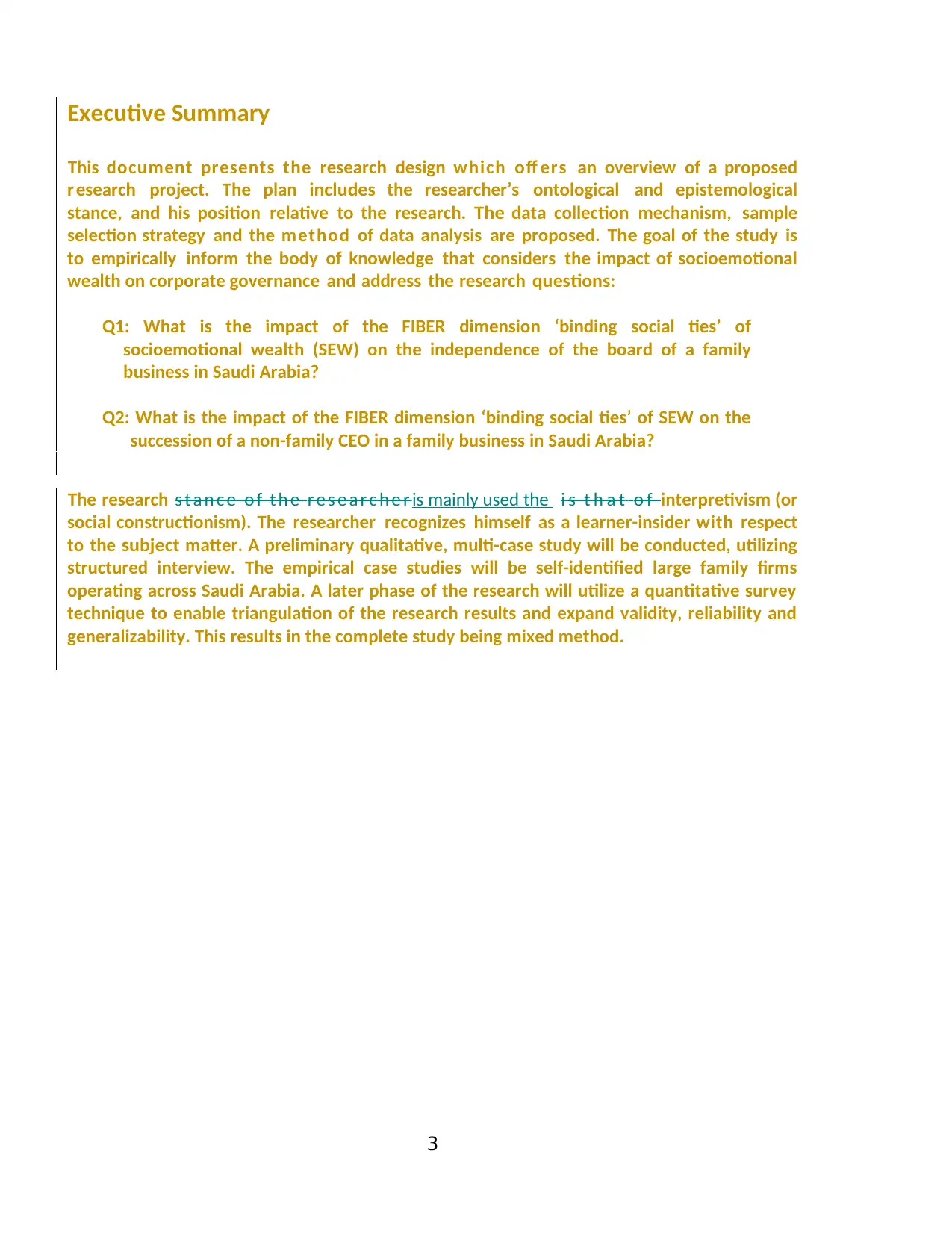
Executive Summary
This document presents the research design which off ers an overview of a proposed
r esearch project. The plan includes the researcher’s ontological and epistemological
stance, and his position relative to the research. The data collection mechanism, sample
selection strategy and the method of data analysis are proposed. The goal of the study is
to empirically inform the body of knowledge that considers the impact of socioemotional
wealth on corporate governance and address the research questions:
Q1: What is the impact of the FIBER dimension ‘binding social ties’ of
socioemotional wealth (SEW) on the independence of the board of a family
business in Saudi Arabia?
Q2: What is the impact of the FIBER dimension ‘binding social ties’ of SEW on the
succession of a non-family CEO in a family business in Saudi Arabia?
The research s t a n c e o f t h e r e s e a r c h e r is mainly used the i s t h a t o f interpretivism (or
social constructionism). The researcher recognizes himself as a learner-insider with respect
to the subject matter. A preliminary qualitative, multi-case study will be conducted, utilizing
structured interview. The empirical case studies will be self-identified large family firms
operating across Saudi Arabia. A later phase of the research will utilize a quantitative survey
technique to enable triangulation of the research results and expand validity, reliability and
generalizability. This results in the complete study being mixed method.
3
This document presents the research design which off ers an overview of a proposed
r esearch project. The plan includes the researcher’s ontological and epistemological
stance, and his position relative to the research. The data collection mechanism, sample
selection strategy and the method of data analysis are proposed. The goal of the study is
to empirically inform the body of knowledge that considers the impact of socioemotional
wealth on corporate governance and address the research questions:
Q1: What is the impact of the FIBER dimension ‘binding social ties’ of
socioemotional wealth (SEW) on the independence of the board of a family
business in Saudi Arabia?
Q2: What is the impact of the FIBER dimension ‘binding social ties’ of SEW on the
succession of a non-family CEO in a family business in Saudi Arabia?
The research s t a n c e o f t h e r e s e a r c h e r is mainly used the i s t h a t o f interpretivism (or
social constructionism). The researcher recognizes himself as a learner-insider with respect
to the subject matter. A preliminary qualitative, multi-case study will be conducted, utilizing
structured interview. The empirical case studies will be self-identified large family firms
operating across Saudi Arabia. A later phase of the research will utilize a quantitative survey
technique to enable triangulation of the research results and expand validity, reliability and
generalizability. This results in the complete study being mixed method.
3
⊘ This is a preview!⊘
Do you want full access?
Subscribe today to unlock all pages.

Trusted by 1+ million students worldwide
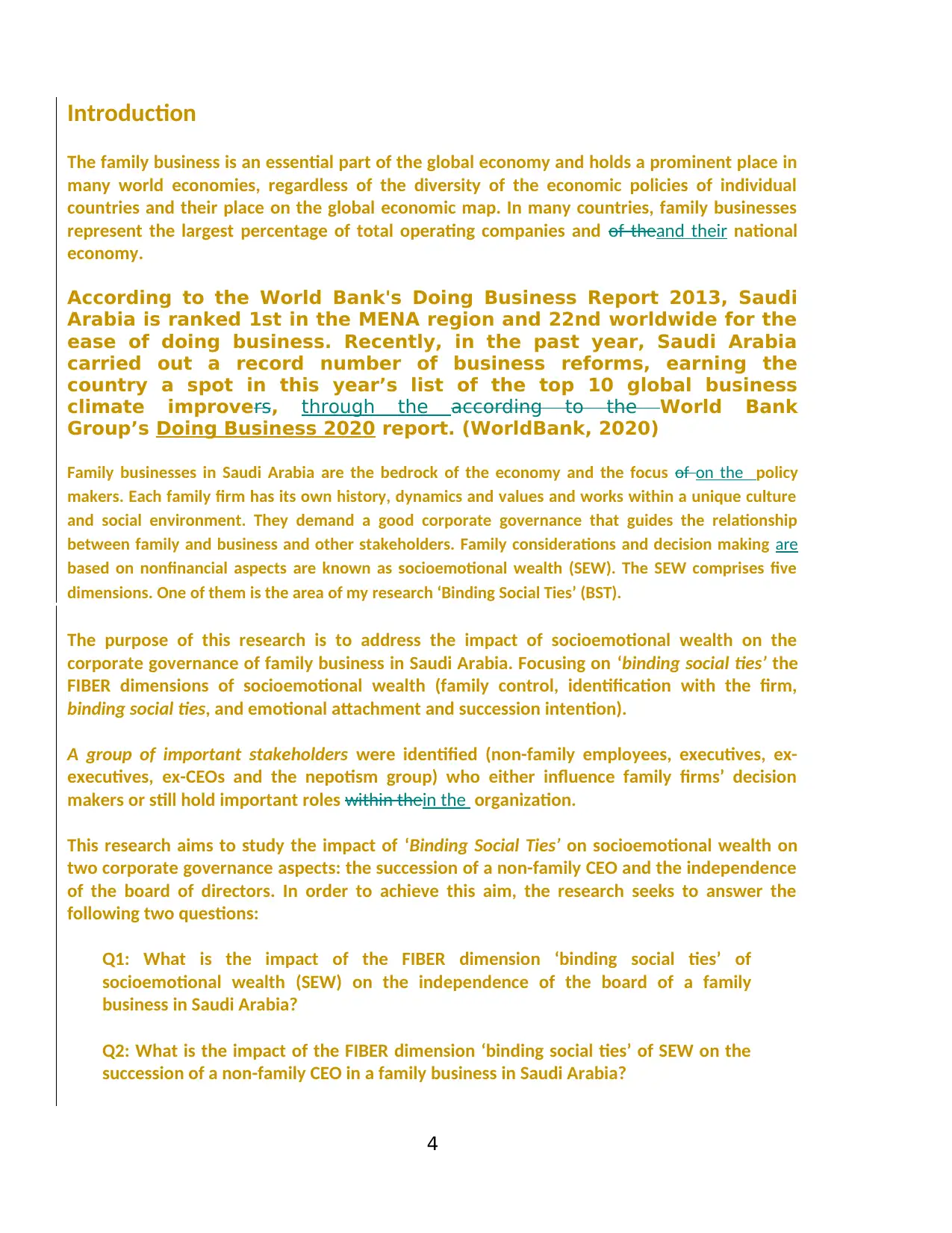
Introduction
The family business is an essential part of the global economy and holds a prominent place in
many world economies, regardless of the diversity of the economic policies of individual
countries and their place on the global economic map. In many countries, family businesses
represent the largest percentage of total operating companies and of theand their national
economy.
According to the World Bank's Doing Business Report 2013, Saudi
Arabia is ranked 1st in the MENA region and 22nd worldwide for the
ease of doing business. Recently, in the past year, Saudi Arabia
carried out a record number of business reforms, earning the
country a spot in this year’s list of the top 10 global business
climate improvers, through the according to the World Bank
Group’s Doing Business 2020 report. (WorldBank, 2020)
Family businesses in Saudi Arabia are the bedrock of the economy and the focus of on the policy
makers. Each family firm has its own history, dynamics and values and works within a unique culture
and social environment. They demand a good corporate governance that guides the relationship
between family and business and other stakeholders. Family considerations and decision making are
based on nonfinancial aspects are known as socioemotional wealth (SEW). The SEW comprises five
dimensions. One of them is the area of my research ‘Binding Social Ties’ (BST).
The purpose of this research is to address the impact of socioemotional wealth on the
corporate governance of family business in Saudi Arabia. Focusing on ‘binding social ties’ the
FIBER dimensions of socioemotional wealth (family control, identification with the firm,
binding social ties, and emotional attachment and succession intention).
A group of important stakeholders were identified (non-family employees, executives, ex-
executives, ex-CEOs and the nepotism group) who either influence family firms’ decision
makers or still hold important roles within thein the organization.
This research aims to study the impact of ‘Binding Social Ties’ on socioemotional wealth on
two corporate governance aspects: the succession of a non-family CEO and the independence
of the board of directors. In order to achieve this aim, the research seeks to answer the
following two questions:
Q1: What is the impact of the FIBER dimension ‘binding social ties’ of
socioemotional wealth (SEW) on the independence of the board of a family
business in Saudi Arabia?
Q2: What is the impact of the FIBER dimension ‘binding social ties’ of SEW on the
succession of a non-family CEO in a family business in Saudi Arabia?
4
The family business is an essential part of the global economy and holds a prominent place in
many world economies, regardless of the diversity of the economic policies of individual
countries and their place on the global economic map. In many countries, family businesses
represent the largest percentage of total operating companies and of theand their national
economy.
According to the World Bank's Doing Business Report 2013, Saudi
Arabia is ranked 1st in the MENA region and 22nd worldwide for the
ease of doing business. Recently, in the past year, Saudi Arabia
carried out a record number of business reforms, earning the
country a spot in this year’s list of the top 10 global business
climate improvers, through the according to the World Bank
Group’s Doing Business 2020 report. (WorldBank, 2020)
Family businesses in Saudi Arabia are the bedrock of the economy and the focus of on the policy
makers. Each family firm has its own history, dynamics and values and works within a unique culture
and social environment. They demand a good corporate governance that guides the relationship
between family and business and other stakeholders. Family considerations and decision making are
based on nonfinancial aspects are known as socioemotional wealth (SEW). The SEW comprises five
dimensions. One of them is the area of my research ‘Binding Social Ties’ (BST).
The purpose of this research is to address the impact of socioemotional wealth on the
corporate governance of family business in Saudi Arabia. Focusing on ‘binding social ties’ the
FIBER dimensions of socioemotional wealth (family control, identification with the firm,
binding social ties, and emotional attachment and succession intention).
A group of important stakeholders were identified (non-family employees, executives, ex-
executives, ex-CEOs and the nepotism group) who either influence family firms’ decision
makers or still hold important roles within thein the organization.
This research aims to study the impact of ‘Binding Social Ties’ on socioemotional wealth on
two corporate governance aspects: the succession of a non-family CEO and the independence
of the board of directors. In order to achieve this aim, the research seeks to answer the
following two questions:
Q1: What is the impact of the FIBER dimension ‘binding social ties’ of
socioemotional wealth (SEW) on the independence of the board of a family
business in Saudi Arabia?
Q2: What is the impact of the FIBER dimension ‘binding social ties’ of SEW on the
succession of a non-family CEO in a family business in Saudi Arabia?
4
Paraphrase This Document
Need a fresh take? Get an instant paraphrase of this document with our AI Paraphraser
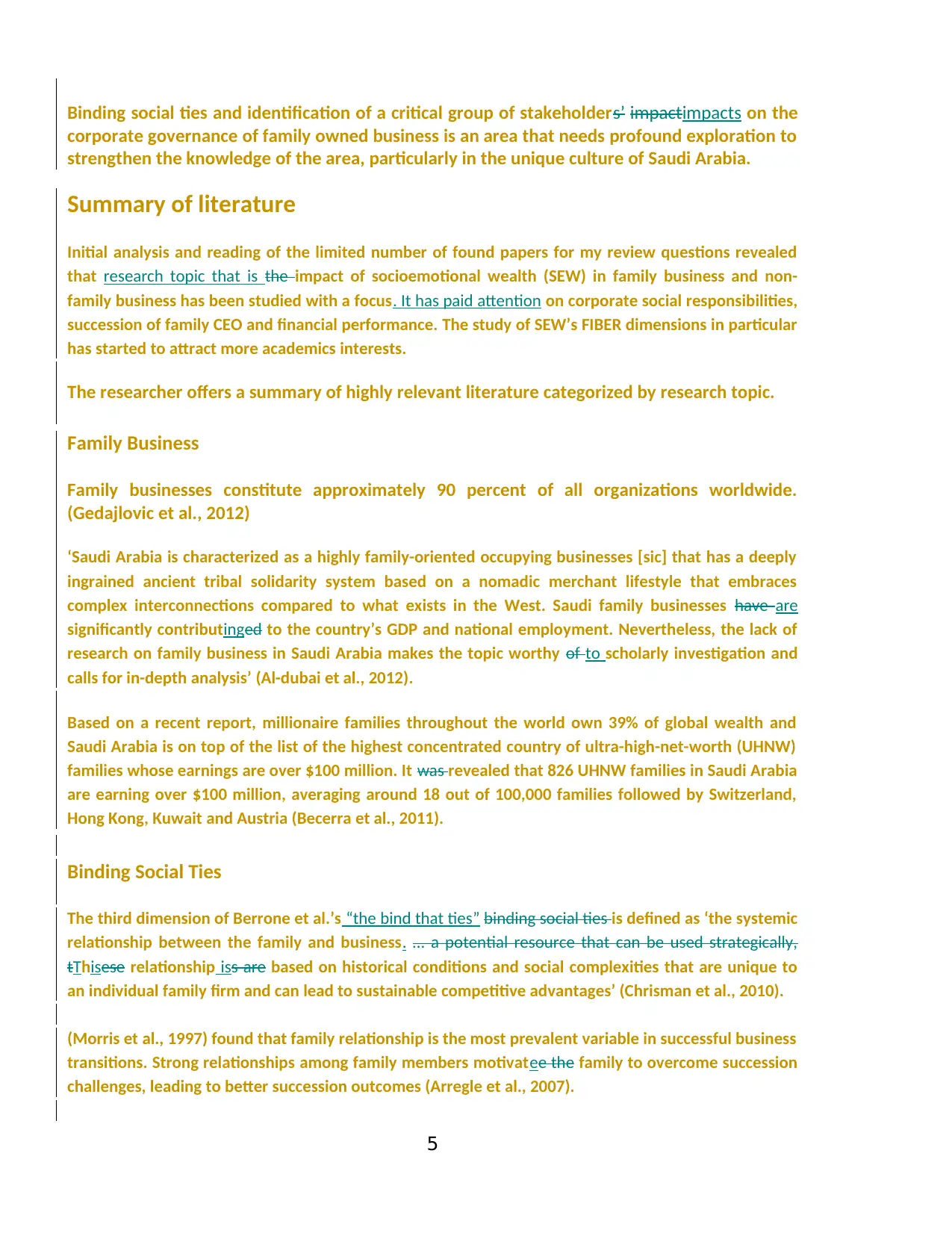
Binding social ties and identification of a critical group of stakeholders’ impactimpacts on the
corporate governance of family owned business is an area that needs profound exploration to
strengthen the knowledge of the area, particularly in the unique culture of Saudi Arabia.
Summary of literature
Initial analysis and reading of the limited number of found papers for my review questions revealed
that research topic that is the impact of socioemotional wealth (SEW) in family business and non-
family business has been studied with a focus. It has paid attention on corporate social responsibilities,
succession of family CEO and financial performance. The study of SEW’s FIBER dimensions in particular
has started to attract more academics interests.
The researcher offers a summary of highly relevant literature categorized by research topic.
Family Business
Family businesses constitute approximately 90 percent of all organizations worldwide.
(Gedajlovic et al., 2012)
‘Saudi Arabia is characterized as a highly family-oriented occupying businesses [sic] that has a deeply
ingrained ancient tribal solidarity system based on a nomadic merchant lifestyle that embraces
complex interconnections compared to what exists in the West. Saudi family businesses have are
significantly contributinged to the country’s GDP and national employment. Nevertheless, the lack of
research on family business in Saudi Arabia makes the topic worthy of to scholarly investigation and
calls for in-depth analysis’ (Al-dubai et al., 2012).
Based on a recent report, millionaire families throughout the world own 39% of global wealth and
Saudi Arabia is on top of the list of the highest concentrated country of ultra-high-net-worth (UHNW)
families whose earnings are over $100 million. It was revealed that 826 UHNW families in Saudi Arabia
are earning over $100 million, averaging around 18 out of 100,000 families followed by Switzerland,
Hong Kong, Kuwait and Austria (Becerra et al., 2011).
Binding Social Ties
The third dimension of Berrone et al.’s “the bind that ties” binding social ties is defined as ‘the systemic
relationship between the family and business. … a potential resource that can be used strategically,
tThisese relationship iss are based on historical conditions and social complexities that are unique to
an individual family firm and can lead to sustainable competitive advantages’ (Chrisman et al., 2010).
(Morris et al., 1997) found that family relationship is the most prevalent variable in successful business
transitions. Strong relationships among family members motivatee the family to overcome succession
challenges, leading to better succession outcomes (Arregle et al., 2007).
5
corporate governance of family owned business is an area that needs profound exploration to
strengthen the knowledge of the area, particularly in the unique culture of Saudi Arabia.
Summary of literature
Initial analysis and reading of the limited number of found papers for my review questions revealed
that research topic that is the impact of socioemotional wealth (SEW) in family business and non-
family business has been studied with a focus. It has paid attention on corporate social responsibilities,
succession of family CEO and financial performance. The study of SEW’s FIBER dimensions in particular
has started to attract more academics interests.
The researcher offers a summary of highly relevant literature categorized by research topic.
Family Business
Family businesses constitute approximately 90 percent of all organizations worldwide.
(Gedajlovic et al., 2012)
‘Saudi Arabia is characterized as a highly family-oriented occupying businesses [sic] that has a deeply
ingrained ancient tribal solidarity system based on a nomadic merchant lifestyle that embraces
complex interconnections compared to what exists in the West. Saudi family businesses have are
significantly contributinged to the country’s GDP and national employment. Nevertheless, the lack of
research on family business in Saudi Arabia makes the topic worthy of to scholarly investigation and
calls for in-depth analysis’ (Al-dubai et al., 2012).
Based on a recent report, millionaire families throughout the world own 39% of global wealth and
Saudi Arabia is on top of the list of the highest concentrated country of ultra-high-net-worth (UHNW)
families whose earnings are over $100 million. It was revealed that 826 UHNW families in Saudi Arabia
are earning over $100 million, averaging around 18 out of 100,000 families followed by Switzerland,
Hong Kong, Kuwait and Austria (Becerra et al., 2011).
Binding Social Ties
The third dimension of Berrone et al.’s “the bind that ties” binding social ties is defined as ‘the systemic
relationship between the family and business. … a potential resource that can be used strategically,
tThisese relationship iss are based on historical conditions and social complexities that are unique to
an individual family firm and can lead to sustainable competitive advantages’ (Chrisman et al., 2010).
(Morris et al., 1997) found that family relationship is the most prevalent variable in successful business
transitions. Strong relationships among family members motivatee the family to overcome succession
challenges, leading to better succession outcomes (Arregle et al., 2007).
5
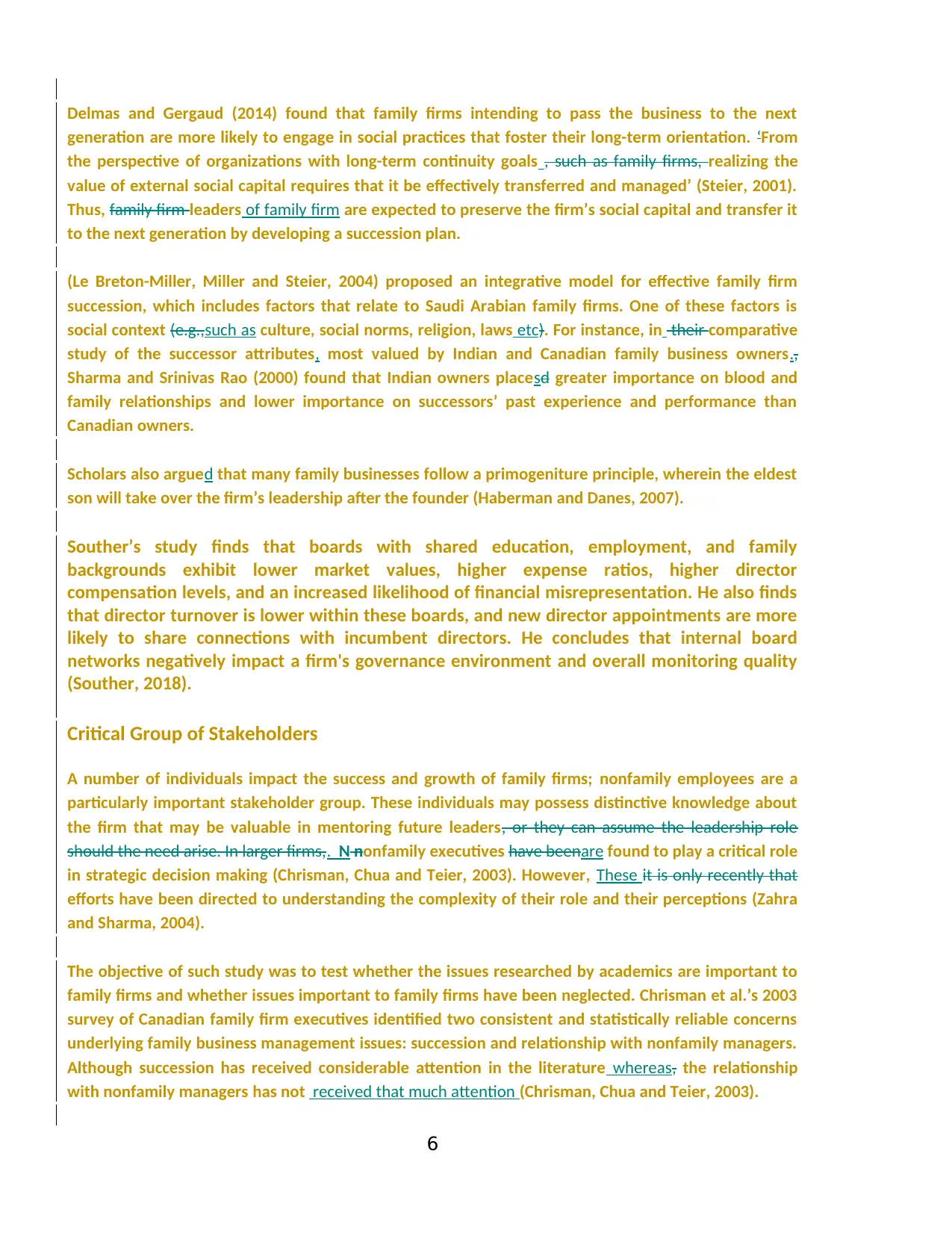
Delmas and Gergaud (2014) found that family firms intending to pass the business to the next
generation are more likely to engage in social practices that foster their long-term orientation. ‘From
the perspective of organizations with long-term continuity goals , such as family firms, realizing the
value of external social capital requires that it be effectively transferred and managed’ (Steier, 2001).
Thus, family firm leaders of family firm are expected to preserve the firm’s social capital and transfer it
to the next generation by developing a succession plan.
(Le Breton-Miller, Miller and Steier, 2004) proposed an integrative model for effective family firm
succession, which includes factors that relate to Saudi Arabian family firms. One of these factors is
social context (e.g.,such as culture, social norms, religion, laws etc). For instance, in their comparative
study of the successor attributes, most valued by Indian and Canadian family business owners.,
Sharma and Srinivas Rao (2000) found that Indian owners placesd greater importance on blood and
family relationships and lower importance on successors’ past experience and performance than
Canadian owners.
Scholars also argued that many family businesses follow a primogeniture principle, wherein the eldest
son will take over the firm’s leadership after the founder (Haberman and Danes, 2007).
Souther’s study finds that boards with shared education, employment, and family
backgrounds exhibit lower market values, higher expense ratios, higher director
compensation levels, and an increased likelihood of financial misrepresentation. He also finds
that director turnover is lower within these boards, and new director appointments are more
likely to share connections with incumbent directors. He concludes that internal board
networks negatively impact a firm's governance environment and overall monitoring quality
(Souther, 2018).
Critical Group of Stakeholders
A number of individuals impact the success and growth of family firms; nonfamily employees are a
particularly important stakeholder group. These individuals may possess distinctive knowledge about
the firm that may be valuable in mentoring future leaders, or they can assume the leadership role
should the need arise. In larger firms,. N nonfamily executives have beenare found to play a critical role
in strategic decision making (Chrisman, Chua and Teier, 2003). However, These it is only recently that
efforts have been directed to understanding the complexity of their role and their perceptions (Zahra
and Sharma, 2004).
The objective of such study was to test whether the issues researched by academics are important to
family firms and whether issues important to family firms have been neglected. Chrisman et al.’s 2003
survey of Canadian family firm executives identified two consistent and statistically reliable concerns
underlying family business management issues: succession and relationship with nonfamily managers.
Although succession has received considerable attention in the literature whereas, the relationship
with nonfamily managers has not received that much attention (Chrisman, Chua and Teier, 2003).
6
generation are more likely to engage in social practices that foster their long-term orientation. ‘From
the perspective of organizations with long-term continuity goals , such as family firms, realizing the
value of external social capital requires that it be effectively transferred and managed’ (Steier, 2001).
Thus, family firm leaders of family firm are expected to preserve the firm’s social capital and transfer it
to the next generation by developing a succession plan.
(Le Breton-Miller, Miller and Steier, 2004) proposed an integrative model for effective family firm
succession, which includes factors that relate to Saudi Arabian family firms. One of these factors is
social context (e.g.,such as culture, social norms, religion, laws etc). For instance, in their comparative
study of the successor attributes, most valued by Indian and Canadian family business owners.,
Sharma and Srinivas Rao (2000) found that Indian owners placesd greater importance on blood and
family relationships and lower importance on successors’ past experience and performance than
Canadian owners.
Scholars also argued that many family businesses follow a primogeniture principle, wherein the eldest
son will take over the firm’s leadership after the founder (Haberman and Danes, 2007).
Souther’s study finds that boards with shared education, employment, and family
backgrounds exhibit lower market values, higher expense ratios, higher director
compensation levels, and an increased likelihood of financial misrepresentation. He also finds
that director turnover is lower within these boards, and new director appointments are more
likely to share connections with incumbent directors. He concludes that internal board
networks negatively impact a firm's governance environment and overall monitoring quality
(Souther, 2018).
Critical Group of Stakeholders
A number of individuals impact the success and growth of family firms; nonfamily employees are a
particularly important stakeholder group. These individuals may possess distinctive knowledge about
the firm that may be valuable in mentoring future leaders, or they can assume the leadership role
should the need arise. In larger firms,. N nonfamily executives have beenare found to play a critical role
in strategic decision making (Chrisman, Chua and Teier, 2003). However, These it is only recently that
efforts have been directed to understanding the complexity of their role and their perceptions (Zahra
and Sharma, 2004).
The objective of such study was to test whether the issues researched by academics are important to
family firms and whether issues important to family firms have been neglected. Chrisman et al.’s 2003
survey of Canadian family firm executives identified two consistent and statistically reliable concerns
underlying family business management issues: succession and relationship with nonfamily managers.
Although succession has received considerable attention in the literature whereas, the relationship
with nonfamily managers has not received that much attention (Chrisman, Chua and Teier, 2003).
6
⊘ This is a preview!⊘
Do you want full access?
Subscribe today to unlock all pages.

Trusted by 1+ million students worldwide
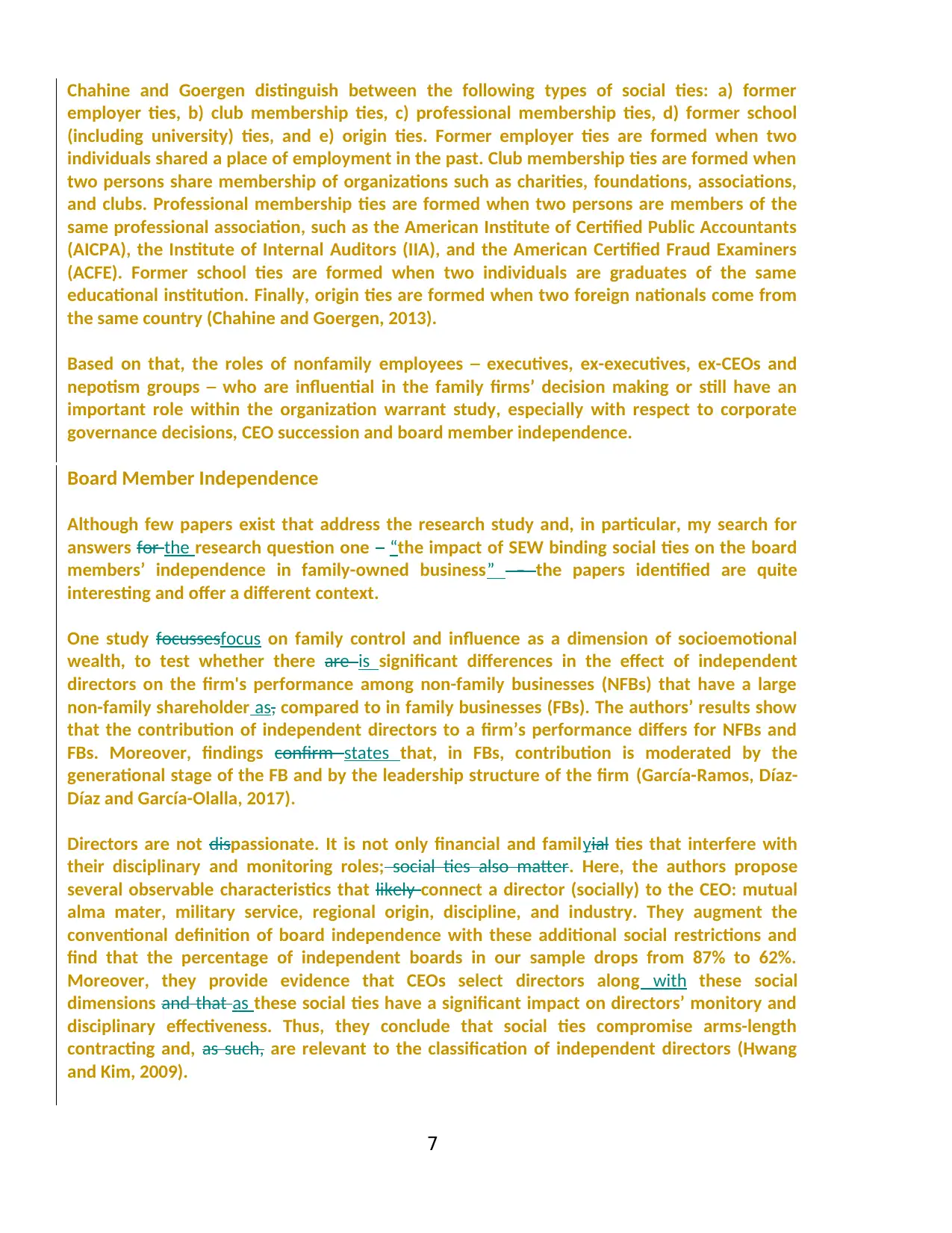
Chahine and Goergen distinguish between the following types of social ties: a) former
employer ties, b) club membership ties, c) professional membership ties, d) former school
(including university) ties, and e) origin ties. Former employer ties are formed when two
individuals shared a place of employment in the past. Club membership ties are formed when
two persons share membership of organizations such as charities, foundations, associations,
and clubs. Professional membership ties are formed when two persons are members of the
same professional association, such as the American Institute of Certified Public Accountants
(AICPA), the Institute of Internal Auditors (IIA), and the American Certified Fraud Examiners
(ACFE). Former school ties are formed when two individuals are graduates of the same
educational institution. Finally, origin ties are formed when two foreign nationals come from
the same country (Chahine and Goergen, 2013).
Based on that, the roles of nonfamily employees ─ executives, ex-executives, ex-CEOs and
nepotism groups ─ who are influential in the family firms’ decision making or still have an
important role within the organization warrant study, especially with respect to corporate
governance decisions, CEO succession and board member independence.
Board Member Independence
Although few papers exist that address the research study and, in particular, my search for
answers for the research question one – “the impact of SEW binding social ties on the board
members’ independence in family-owned business” – the papers identified are quite
interesting and offer a different context.
One study focussesfocus on family control and influence as a dimension of socioemotional
wealth, to test whether there are is significant differences in the effect of independent
directors on the firm's performance among non-family businesses (NFBs) that have a large
non-family shareholder as, compared to in family businesses (FBs). The authors’ results show
that the contribution of independent directors to a firm’s performance differs for NFBs and
FBs. Moreover, findings confirm states that, in FBs, contribution is moderated by the
generational stage of the FB and by the leadership structure of the firm (García-Ramos, Díaz-
Díaz and García-Olalla, 2017).
Directors are not dispassionate. It is not only financial and familyial ties that interfere with
their disciplinary and monitoring roles; social ties also matter. Here, the authors propose
several observable characteristics that likely connect a director (socially) to the CEO: mutual
alma mater, military service, regional origin, discipline, and industry. They augment the
conventional definition of board independence with these additional social restrictions and
find that the percentage of independent boards in our sample drops from 87% to 62%.
Moreover, they provide evidence that CEOs select directors along with these social
dimensions and that as these social ties have a significant impact on directors’ monitory and
disciplinary effectiveness. Thus, they conclude that social ties compromise arms-length
contracting and, as such, are relevant to the classification of independent directors (Hwang
and Kim, 2009).
7
employer ties, b) club membership ties, c) professional membership ties, d) former school
(including university) ties, and e) origin ties. Former employer ties are formed when two
individuals shared a place of employment in the past. Club membership ties are formed when
two persons share membership of organizations such as charities, foundations, associations,
and clubs. Professional membership ties are formed when two persons are members of the
same professional association, such as the American Institute of Certified Public Accountants
(AICPA), the Institute of Internal Auditors (IIA), and the American Certified Fraud Examiners
(ACFE). Former school ties are formed when two individuals are graduates of the same
educational institution. Finally, origin ties are formed when two foreign nationals come from
the same country (Chahine and Goergen, 2013).
Based on that, the roles of nonfamily employees ─ executives, ex-executives, ex-CEOs and
nepotism groups ─ who are influential in the family firms’ decision making or still have an
important role within the organization warrant study, especially with respect to corporate
governance decisions, CEO succession and board member independence.
Board Member Independence
Although few papers exist that address the research study and, in particular, my search for
answers for the research question one – “the impact of SEW binding social ties on the board
members’ independence in family-owned business” – the papers identified are quite
interesting and offer a different context.
One study focussesfocus on family control and influence as a dimension of socioemotional
wealth, to test whether there are is significant differences in the effect of independent
directors on the firm's performance among non-family businesses (NFBs) that have a large
non-family shareholder as, compared to in family businesses (FBs). The authors’ results show
that the contribution of independent directors to a firm’s performance differs for NFBs and
FBs. Moreover, findings confirm states that, in FBs, contribution is moderated by the
generational stage of the FB and by the leadership structure of the firm (García-Ramos, Díaz-
Díaz and García-Olalla, 2017).
Directors are not dispassionate. It is not only financial and familyial ties that interfere with
their disciplinary and monitoring roles; social ties also matter. Here, the authors propose
several observable characteristics that likely connect a director (socially) to the CEO: mutual
alma mater, military service, regional origin, discipline, and industry. They augment the
conventional definition of board independence with these additional social restrictions and
find that the percentage of independent boards in our sample drops from 87% to 62%.
Moreover, they provide evidence that CEOs select directors along with these social
dimensions and that as these social ties have a significant impact on directors’ monitory and
disciplinary effectiveness. Thus, they conclude that social ties compromise arms-length
contracting and, as such, are relevant to the classification of independent directors (Hwang
and Kim, 2009).
7
Paraphrase This Document
Need a fresh take? Get an instant paraphrase of this document with our AI Paraphraser
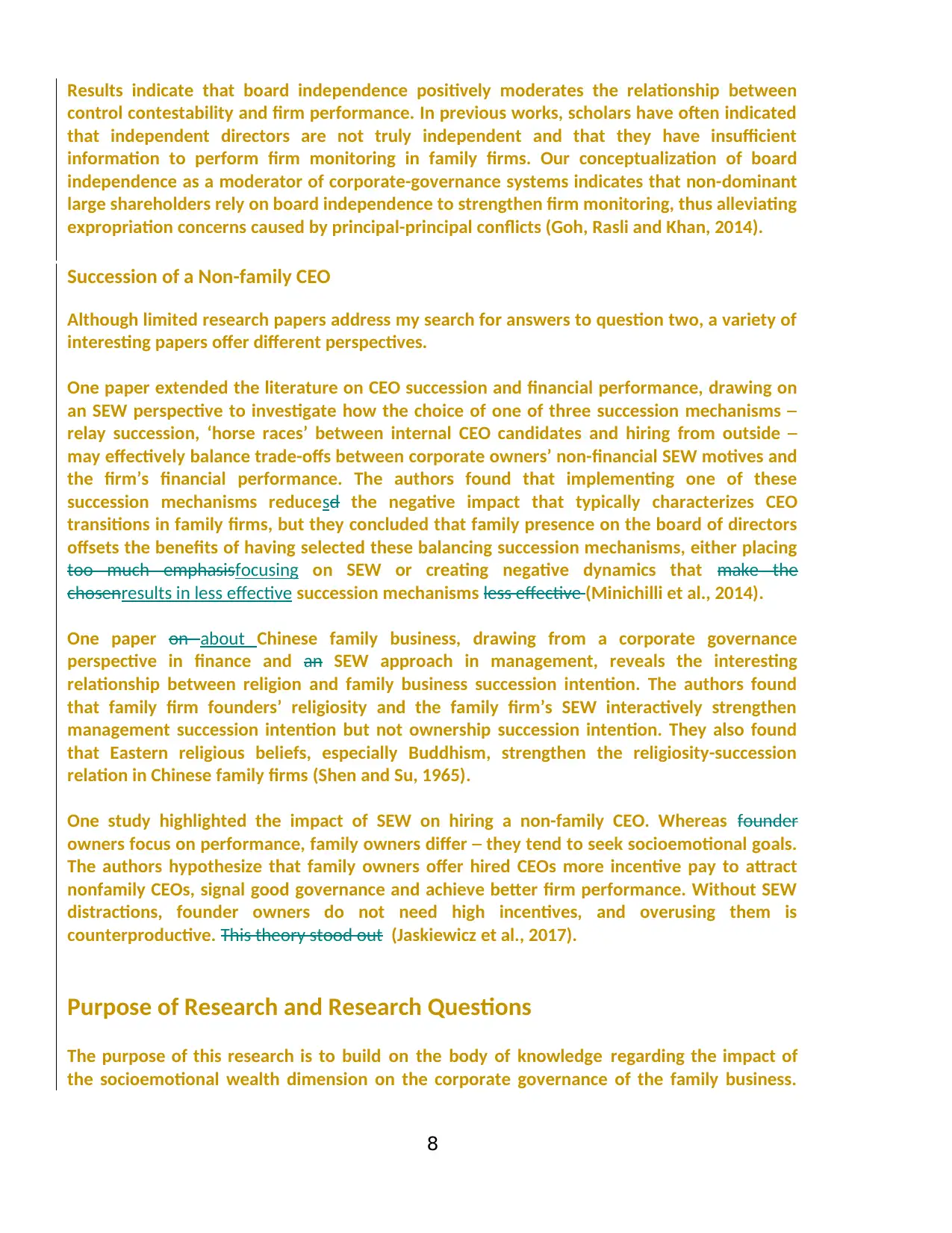
Results indicate that board independence positively moderates the relationship between
control contestability and firm performance. In previous works, scholars have often indicated
that independent directors are not truly independent and that they have insufficient
information to perform firm monitoring in family firms. Our conceptualization of board
independence as a moderator of corporate-governance systems indicates that non-dominant
large shareholders rely on board independence to strengthen firm monitoring, thus alleviating
expropriation concerns caused by principal-principal conflicts (Goh, Rasli and Khan, 2014).
Succession of a Non-family CEO
Although limited research papers address my search for answers to question two, a variety of
interesting papers offer different perspectives.
One paper extended the literature on CEO succession and financial performance, drawing on
an SEW perspective to investigate how the choice of one of three succession mechanisms ─
relay succession, ‘horse races’ between internal CEO candidates and hiring from outside ─
may effectively balance trade-offs between corporate owners’ non-financial SEW motives and
the firm’s financial performance. The authors found that implementing one of these
succession mechanisms reducesd the negative impact that typically characterizes CEO
transitions in family firms, but they concluded that family presence on the board of directors
offsets the benefits of having selected these balancing succession mechanisms, either placing
too much emphasisfocusing on SEW or creating negative dynamics that make the
chosenresults in less effective succession mechanisms less effective (Minichilli et al., 2014).
One paper on about Chinese family business, drawing from a corporate governance
perspective in finance and an SEW approach in management, reveals the interesting
relationship between religion and family business succession intention. The authors found
that family firm founders’ religiosity and the family firm’s SEW interactively strengthen
management succession intention but not ownership succession intention. They also found
that Eastern religious beliefs, especially Buddhism, strengthen the religiosity-succession
relation in Chinese family firms (Shen and Su, 1965).
One study highlighted the impact of SEW on hiring a non-family CEO. Whereas founder
owners focus on performance, family owners differ ─ they tend to seek socioemotional goals.
The authors hypothesize that family owners offer hired CEOs more incentive pay to attract
nonfamily CEOs, signal good governance and achieve better firm performance. Without SEW
distractions, founder owners do not need high incentives, and overusing them is
counterproductive. This theory stood out (Jaskiewicz et al., 2017).
Purpose of Research and Research Questions
The purpose of this research is to build on the body of knowledge regarding the impact of
the socioemotional wealth dimension on the corporate governance of the family business.
8
control contestability and firm performance. In previous works, scholars have often indicated
that independent directors are not truly independent and that they have insufficient
information to perform firm monitoring in family firms. Our conceptualization of board
independence as a moderator of corporate-governance systems indicates that non-dominant
large shareholders rely on board independence to strengthen firm monitoring, thus alleviating
expropriation concerns caused by principal-principal conflicts (Goh, Rasli and Khan, 2014).
Succession of a Non-family CEO
Although limited research papers address my search for answers to question two, a variety of
interesting papers offer different perspectives.
One paper extended the literature on CEO succession and financial performance, drawing on
an SEW perspective to investigate how the choice of one of three succession mechanisms ─
relay succession, ‘horse races’ between internal CEO candidates and hiring from outside ─
may effectively balance trade-offs between corporate owners’ non-financial SEW motives and
the firm’s financial performance. The authors found that implementing one of these
succession mechanisms reducesd the negative impact that typically characterizes CEO
transitions in family firms, but they concluded that family presence on the board of directors
offsets the benefits of having selected these balancing succession mechanisms, either placing
too much emphasisfocusing on SEW or creating negative dynamics that make the
chosenresults in less effective succession mechanisms less effective (Minichilli et al., 2014).
One paper on about Chinese family business, drawing from a corporate governance
perspective in finance and an SEW approach in management, reveals the interesting
relationship between religion and family business succession intention. The authors found
that family firm founders’ religiosity and the family firm’s SEW interactively strengthen
management succession intention but not ownership succession intention. They also found
that Eastern religious beliefs, especially Buddhism, strengthen the religiosity-succession
relation in Chinese family firms (Shen and Su, 1965).
One study highlighted the impact of SEW on hiring a non-family CEO. Whereas founder
owners focus on performance, family owners differ ─ they tend to seek socioemotional goals.
The authors hypothesize that family owners offer hired CEOs more incentive pay to attract
nonfamily CEOs, signal good governance and achieve better firm performance. Without SEW
distractions, founder owners do not need high incentives, and overusing them is
counterproductive. This theory stood out (Jaskiewicz et al., 2017).
Purpose of Research and Research Questions
The purpose of this research is to build on the body of knowledge regarding the impact of
the socioemotional wealth dimension on the corporate governance of the family business.
8
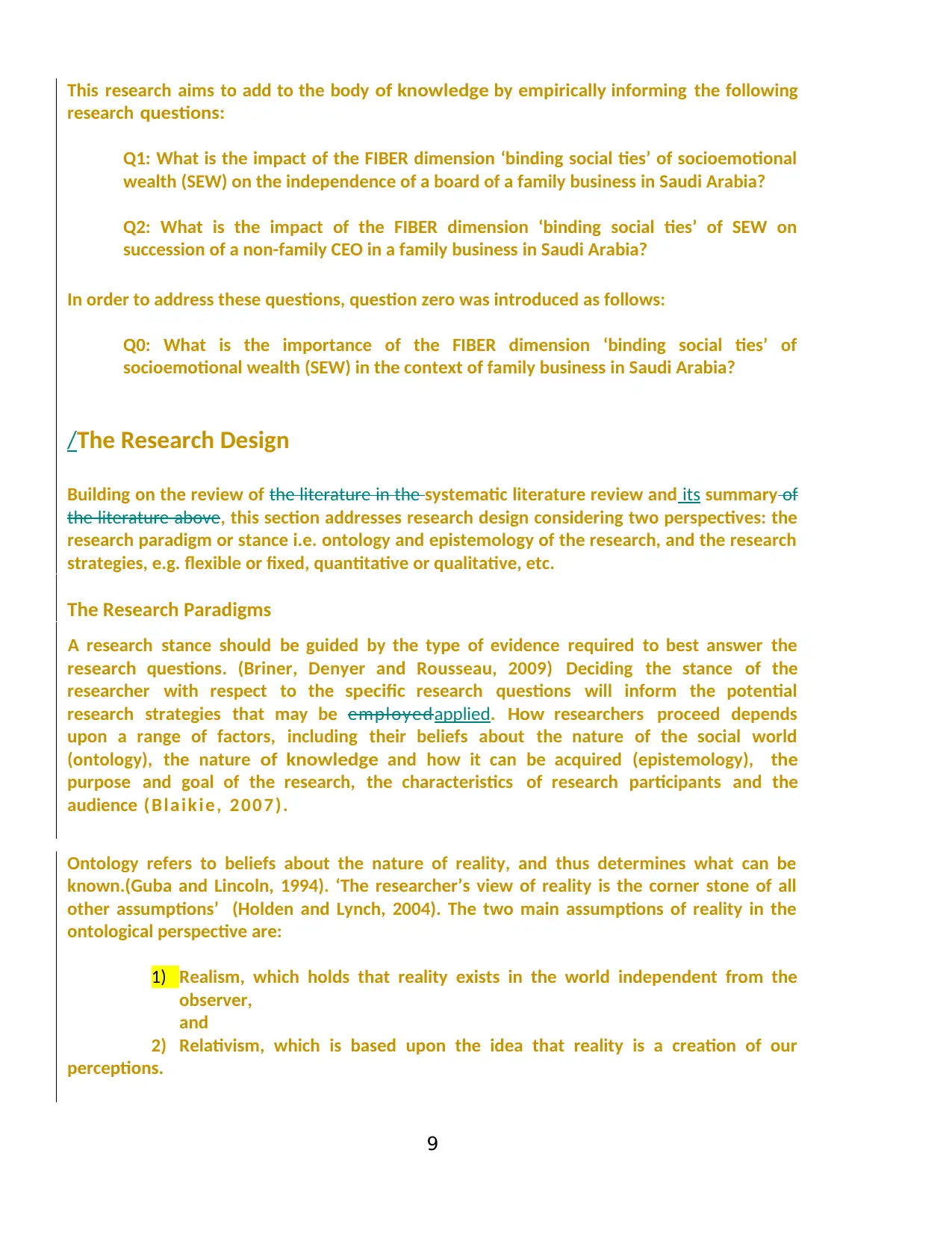
This research aims to add to the body of knowledge by empirically informing the following
research questions:
Q1: What is the impact of the FIBER dimension ‘binding social ties’ of socioemotional
wealth (SEW) on the independence of a board of a family business in Saudi Arabia?
Q2: What is the impact of the FIBER dimension ‘binding social ties’ of SEW on
succession of a non-family CEO in a family business in Saudi Arabia?
In order to address these questions, question zero was introduced as follows:
Q0: What is the importance of the FIBER dimension ‘binding social ties’ of
socioemotional wealth (SEW) in the context of family business in Saudi Arabia?
/The Research Design
Building on the review of the literature in the systematic literature review and its summary of
the literature above, this section addresses research design considering two perspectives: the
research paradigm or stance i.e. ontology and epistemology of the research, and the research
strategies, e.g. flexible or fixed, quantitative or qualitative, etc.
The Research Paradigms
A research stance should be guided by the type of evidence required to best answer the
research questions. (Briner, Denyer and Rousseau, 2009) Deciding the stance of the
researcher with respect to the specific research questions will inform the potential
research strategies that may be employedapplied. How researchers proceed depends
upon a range of factors, including their beliefs about the nature of the social world
(ontology), the nature of knowledge and how it can be acquired (epistemology), the
purpose and goal of the research, the characteristics of research participants and the
audience ( Bl a ik i e, 200 7) .
Ontology refers to beliefs about the nature of reality, and thus determines what can be
known.(Guba and Lincoln, 1994). ‘The researcher’s view of reality is the corner stone of all
other assumptions’ (Holden and Lynch, 2004). The two main assumptions of reality in the
ontological perspective are:
1) Realism, which holds that reality exists in the world independent from the
observer,
and
2) Relativism, which is based upon the idea that reality is a creation of our
perceptions.
9
research questions:
Q1: What is the impact of the FIBER dimension ‘binding social ties’ of socioemotional
wealth (SEW) on the independence of a board of a family business in Saudi Arabia?
Q2: What is the impact of the FIBER dimension ‘binding social ties’ of SEW on
succession of a non-family CEO in a family business in Saudi Arabia?
In order to address these questions, question zero was introduced as follows:
Q0: What is the importance of the FIBER dimension ‘binding social ties’ of
socioemotional wealth (SEW) in the context of family business in Saudi Arabia?
/The Research Design
Building on the review of the literature in the systematic literature review and its summary of
the literature above, this section addresses research design considering two perspectives: the
research paradigm or stance i.e. ontology and epistemology of the research, and the research
strategies, e.g. flexible or fixed, quantitative or qualitative, etc.
The Research Paradigms
A research stance should be guided by the type of evidence required to best answer the
research questions. (Briner, Denyer and Rousseau, 2009) Deciding the stance of the
researcher with respect to the specific research questions will inform the potential
research strategies that may be employedapplied. How researchers proceed depends
upon a range of factors, including their beliefs about the nature of the social world
(ontology), the nature of knowledge and how it can be acquired (epistemology), the
purpose and goal of the research, the characteristics of research participants and the
audience ( Bl a ik i e, 200 7) .
Ontology refers to beliefs about the nature of reality, and thus determines what can be
known.(Guba and Lincoln, 1994). ‘The researcher’s view of reality is the corner stone of all
other assumptions’ (Holden and Lynch, 2004). The two main assumptions of reality in the
ontological perspective are:
1) Realism, which holds that reality exists in the world independent from the
observer,
and
2) Relativism, which is based upon the idea that reality is a creation of our
perceptions.
9
⊘ This is a preview!⊘
Do you want full access?
Subscribe today to unlock all pages.

Trusted by 1+ million students worldwide
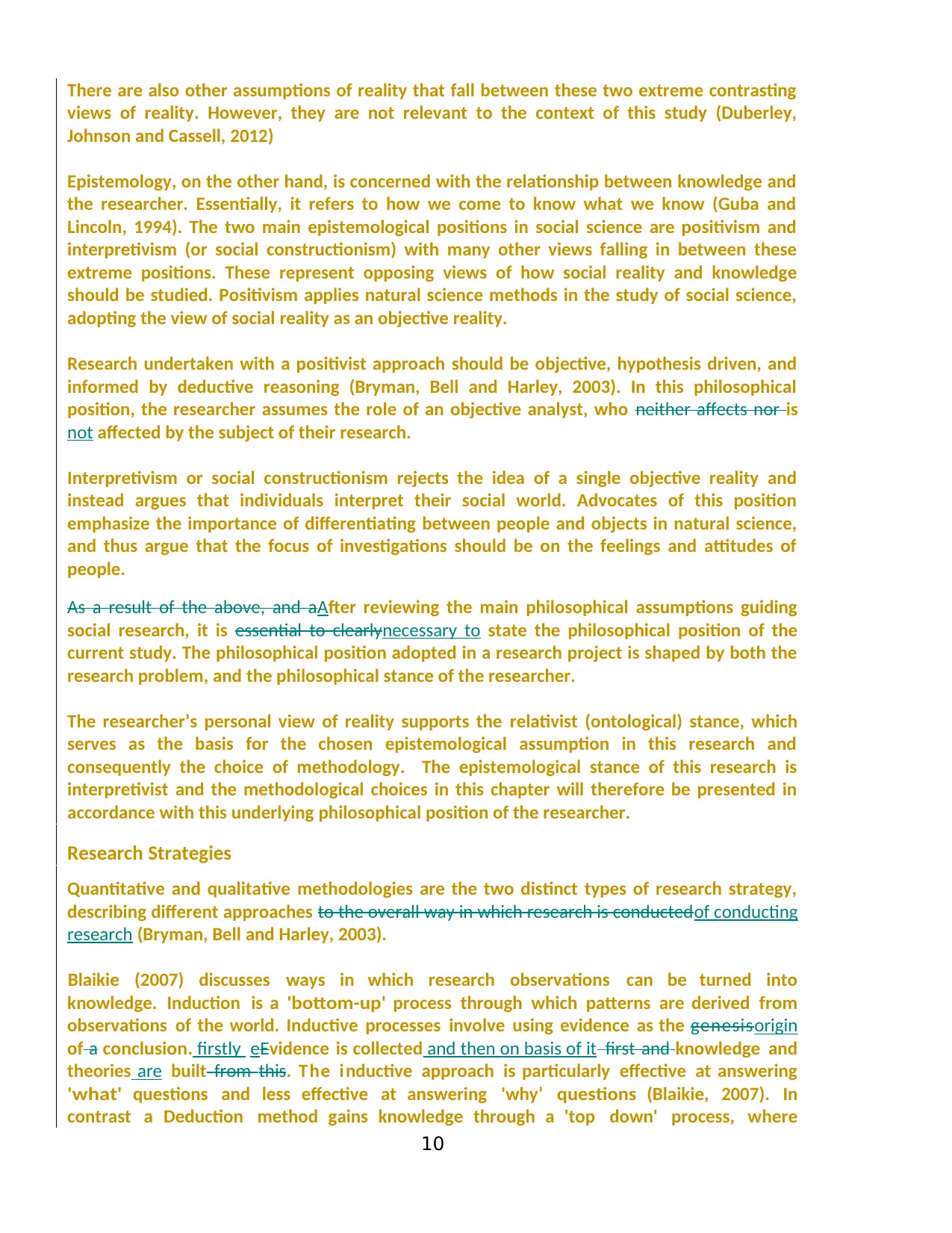
There are also other assumptions of reality that fall between these two extreme contrasting
views of reality. However, they are not relevant to the context of this study (Duberley,
Johnson and Cassell, 2012)
Epistemology, on the other hand, is concerned with the relationship between knowledge and
the researcher. Essentially, it refers to how we come to know what we know (Guba and
Lincoln, 1994). The two main epistemological positions in social science are positivism and
interpretivism (or social constructionism) with many other views falling in between these
extreme positions. These represent opposing views of how social reality and knowledge
should be studied. Positivism applies natural science methods in the study of social science,
adopting the view of social reality as an objective reality.
Research undertaken with a positivist approach should be objective, hypothesis driven, and
informed by deductive reasoning (Bryman, Bell and Harley, 2003). In this philosophical
position, the researcher assumes the role of an objective analyst, who neither affects nor is
not affected by the subject of their research.
Interpretivism or social constructionism rejects the idea of a single objective reality and
instead argues that individuals interpret their social world. Advocates of this position
emphasize the importance of differentiating between people and objects in natural science,
and thus argue that the focus of investigations should be on the feelings and attitudes of
people.
As a result of the above, and aAfter reviewing the main philosophical assumptions guiding
social research, it is essential to clearlynecessary to state the philosophical position of the
current study. The philosophical position adopted in a research project is shaped by both the
research problem, and the philosophical stance of the researcher.
The researcher’s personal view of reality supports the relativist (ontological) stance, which
serves as the basis for the chosen epistemological assumption in this research and
consequently the choice of methodology. The epistemological stance of this research is
interpretivist and the methodological choices in this chapter will therefore be presented in
accordance with this underlying philosophical position of the researcher.
Research Strategies
Quantitative and qualitative methodologies are the two distinct types of research strategy,
describing different approaches to the overall way in which research is conductedof conducting
research (Bryman, Bell and Harley, 2003).
Blaikie (2007) discusses ways in which research observations can be turned into
knowledge. Induction is a 'bottom-up' process through which patterns are derived from
observations of the world. Inductive processes involve using evidence as the genesisorigin
of a conclusion. firstly eEvidence is collected and then on basis of it first and knowledge and
theories are built from this. The inductive approach is particularly effective at answering
'what' questions and less effective at answering 'why’ questions (Blaikie, 2007). In
contrast a Deduction method gains knowledge through a 'top down' process, where
10
views of reality. However, they are not relevant to the context of this study (Duberley,
Johnson and Cassell, 2012)
Epistemology, on the other hand, is concerned with the relationship between knowledge and
the researcher. Essentially, it refers to how we come to know what we know (Guba and
Lincoln, 1994). The two main epistemological positions in social science are positivism and
interpretivism (or social constructionism) with many other views falling in between these
extreme positions. These represent opposing views of how social reality and knowledge
should be studied. Positivism applies natural science methods in the study of social science,
adopting the view of social reality as an objective reality.
Research undertaken with a positivist approach should be objective, hypothesis driven, and
informed by deductive reasoning (Bryman, Bell and Harley, 2003). In this philosophical
position, the researcher assumes the role of an objective analyst, who neither affects nor is
not affected by the subject of their research.
Interpretivism or social constructionism rejects the idea of a single objective reality and
instead argues that individuals interpret their social world. Advocates of this position
emphasize the importance of differentiating between people and objects in natural science,
and thus argue that the focus of investigations should be on the feelings and attitudes of
people.
As a result of the above, and aAfter reviewing the main philosophical assumptions guiding
social research, it is essential to clearlynecessary to state the philosophical position of the
current study. The philosophical position adopted in a research project is shaped by both the
research problem, and the philosophical stance of the researcher.
The researcher’s personal view of reality supports the relativist (ontological) stance, which
serves as the basis for the chosen epistemological assumption in this research and
consequently the choice of methodology. The epistemological stance of this research is
interpretivist and the methodological choices in this chapter will therefore be presented in
accordance with this underlying philosophical position of the researcher.
Research Strategies
Quantitative and qualitative methodologies are the two distinct types of research strategy,
describing different approaches to the overall way in which research is conductedof conducting
research (Bryman, Bell and Harley, 2003).
Blaikie (2007) discusses ways in which research observations can be turned into
knowledge. Induction is a 'bottom-up' process through which patterns are derived from
observations of the world. Inductive processes involve using evidence as the genesisorigin
of a conclusion. firstly eEvidence is collected and then on basis of it first and knowledge and
theories are built from this. The inductive approach is particularly effective at answering
'what' questions and less effective at answering 'why’ questions (Blaikie, 2007). In
contrast a Deduction method gains knowledge through a 'top down' process, where
10
Paraphrase This Document
Need a fresh take? Get an instant paraphrase of this document with our AI Paraphraser
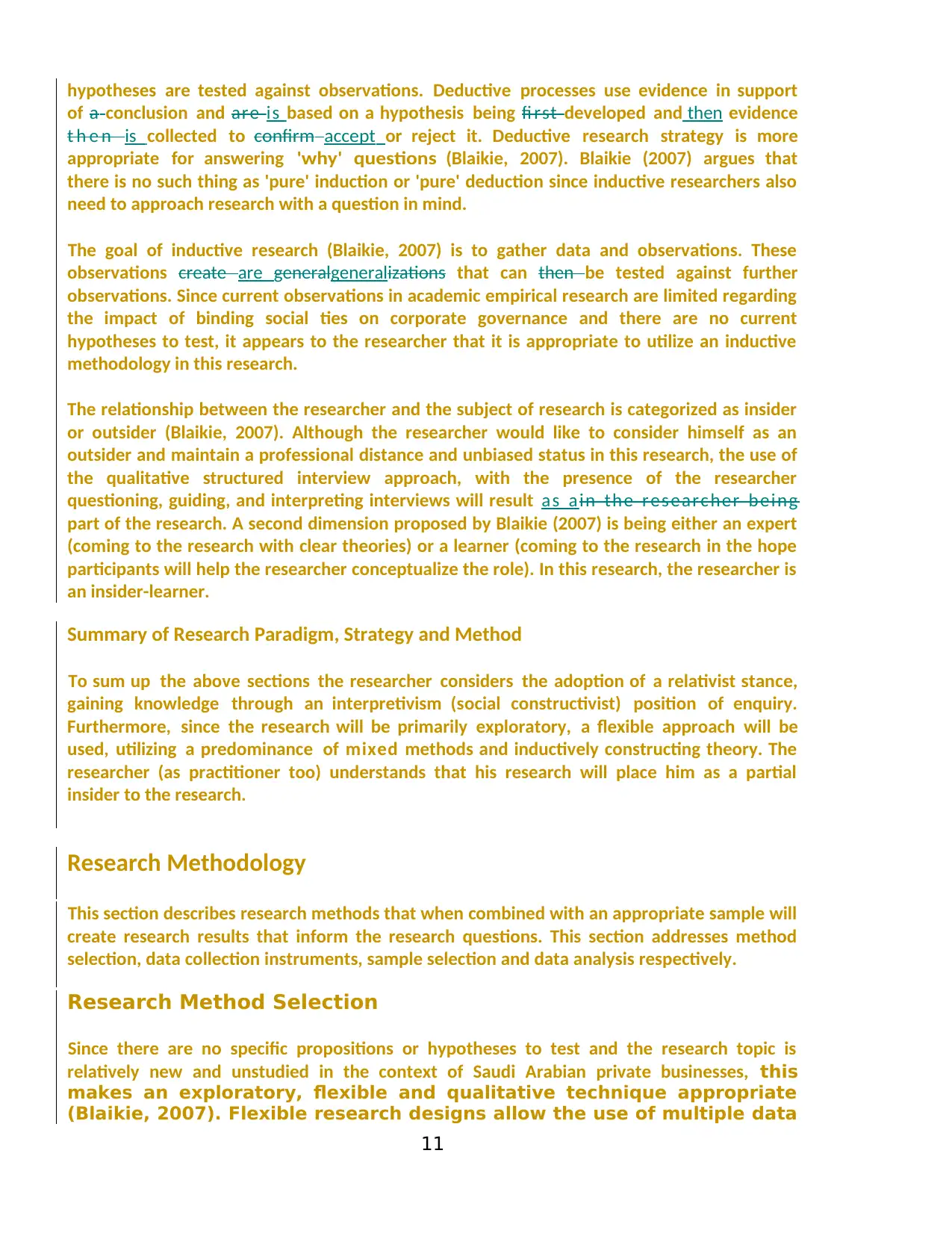
hypotheses are tested against observations. Deductive processes use evidence in support
of a conclusion and are is based on a hypothesis being fi rst developed and then evidence
t h e n is collected to confirm accept or reject it. Deductive research strategy is more
appropriate for answering 'why' questions (Blaikie, 2007). Blaikie (2007) argues that
there is no such thing as 'pure' induction or 'pure' deduction since inductive researchers also
need to approach research with a question in mind.
The goal of inductive research (Blaikie, 2007) is to gather data and observations. These
observations create are generalgeneralizations that can then be tested against further
observations. Since current observations in academic empirical research are limited regarding
the impact of binding social ties on corporate governance and there are no current
hypotheses to test, it appears to the researcher that it is appropriate to utilize an inductive
methodology in this research.
The relationship between the researcher and the subject of research is categorized as insider
or outsider (Blaikie, 2007). Although the researcher would like to consider himself as an
outsider and maintain a professional distance and unbiased status in this research, the use of
the qualitative structured interview approach, with the presence of the researcher
questioning, guiding, and interpreting interviews will result as ain the researcher bei ng
part of the research. A second dimension proposed by Blaikie (2007) is being either an expert
(coming to the research with clear theories) or a learner (coming to the research in the hope
participants will help the researcher conceptualize the role). In this research, the researcher is
an insider-learner.
Summary of Research Paradigm, Strategy and Method
To sum up the above sections the researcher considers the adoption of a relativist stance,
gaining knowledge through an interpretivism (social constructivist) position of enquiry.
Furthermore, since the research will be primarily exploratory, a flexible approach will be
used, utilizing a predominance of mixed methods and inductively constructing theory. The
researcher (as practitioner too) understands that his research will place him as a partial
insider to the research.
Research Methodology
This section describes research methods that when combined with an appropriate sample will
create research results that inform the research questions. This section addresses method
selection, data collection instruments, sample selection and data analysis respectively.
Research Method Selection
Since there are no specific propositions or hypotheses to test and the research topic is
relatively new and unstudied in the context of Saudi Arabian private businesses, this
makes an exploratory, flexible and qualitative technique appropriate
(Blaikie, 2007). Flexible research designs allow the use of multiple data
11
of a conclusion and are is based on a hypothesis being fi rst developed and then evidence
t h e n is collected to confirm accept or reject it. Deductive research strategy is more
appropriate for answering 'why' questions (Blaikie, 2007). Blaikie (2007) argues that
there is no such thing as 'pure' induction or 'pure' deduction since inductive researchers also
need to approach research with a question in mind.
The goal of inductive research (Blaikie, 2007) is to gather data and observations. These
observations create are generalgeneralizations that can then be tested against further
observations. Since current observations in academic empirical research are limited regarding
the impact of binding social ties on corporate governance and there are no current
hypotheses to test, it appears to the researcher that it is appropriate to utilize an inductive
methodology in this research.
The relationship between the researcher and the subject of research is categorized as insider
or outsider (Blaikie, 2007). Although the researcher would like to consider himself as an
outsider and maintain a professional distance and unbiased status in this research, the use of
the qualitative structured interview approach, with the presence of the researcher
questioning, guiding, and interpreting interviews will result as ain the researcher bei ng
part of the research. A second dimension proposed by Blaikie (2007) is being either an expert
(coming to the research with clear theories) or a learner (coming to the research in the hope
participants will help the researcher conceptualize the role). In this research, the researcher is
an insider-learner.
Summary of Research Paradigm, Strategy and Method
To sum up the above sections the researcher considers the adoption of a relativist stance,
gaining knowledge through an interpretivism (social constructivist) position of enquiry.
Furthermore, since the research will be primarily exploratory, a flexible approach will be
used, utilizing a predominance of mixed methods and inductively constructing theory. The
researcher (as practitioner too) understands that his research will place him as a partial
insider to the research.
Research Methodology
This section describes research methods that when combined with an appropriate sample will
create research results that inform the research questions. This section addresses method
selection, data collection instruments, sample selection and data analysis respectively.
Research Method Selection
Since there are no specific propositions or hypotheses to test and the research topic is
relatively new and unstudied in the context of Saudi Arabian private businesses, this
makes an exploratory, flexible and qualitative technique appropriate
(Blaikie, 2007). Flexible research designs allow the use of multiple data
11
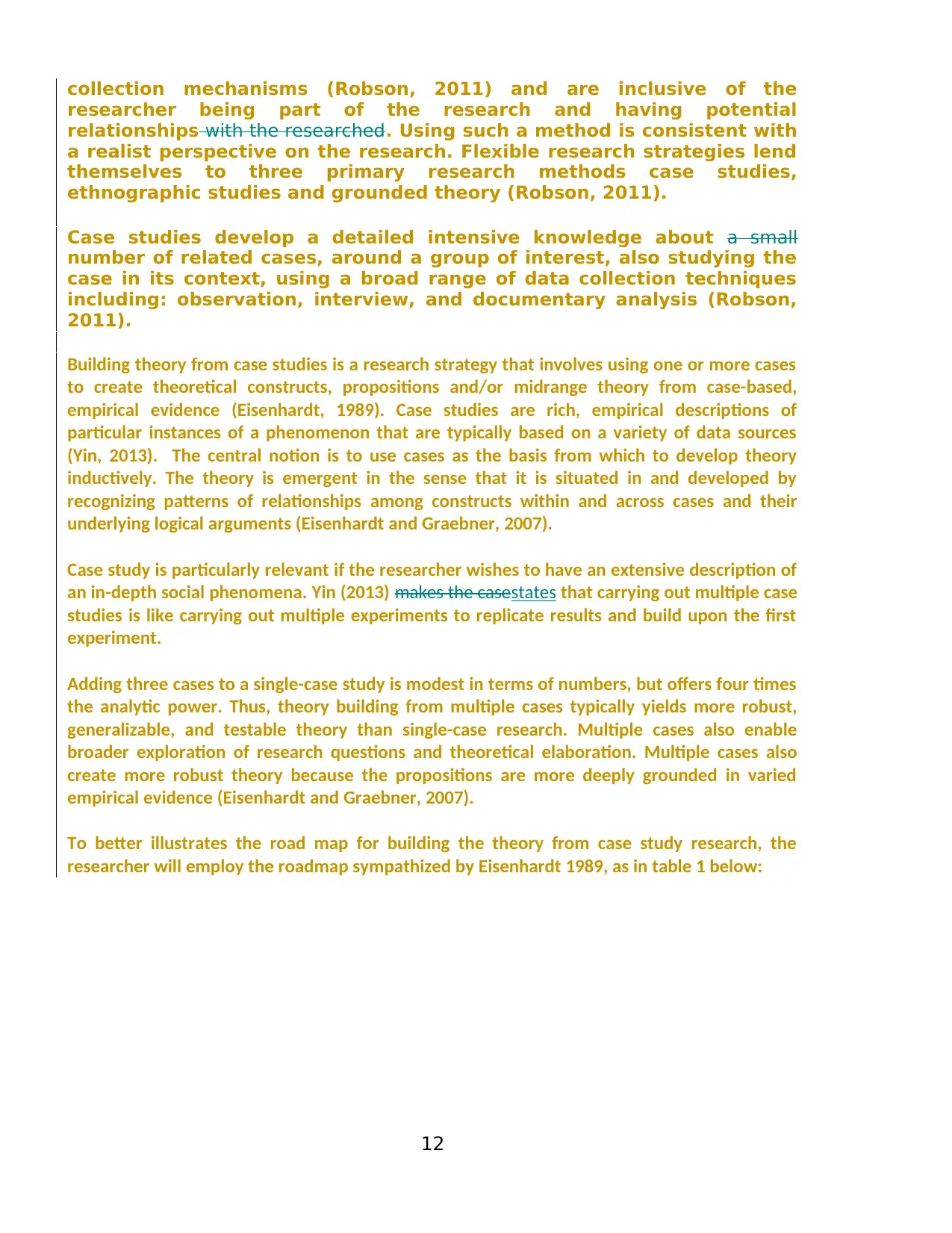
collection mechanisms (Robson, 2011) and are inclusive of the
researcher being part of the research and having potential
relationships with the researched. Using such a method is consistent with
a realist perspective on the research. Flexible research strategies lend
themselves to three primary research methods case studies,
ethnographic studies and grounded theory (Robson, 2011).
Case studies develop a detailed intensive knowledge about a small
number of related cases, around a group of interest, also studying the
case in its context, using a broad range of data collection techniques
including: observation, interview, and documentary analysis (Robson,
2011).
Building theory from case studies is a research strategy that involves using one or more cases
to create theoretical constructs, propositions and/or midrange theory from case-based,
empirical evidence (Eisenhardt, 1989). Case studies are rich, empirical descriptions of
particular instances of a phenomenon that are typically based on a variety of data sources
(Yin, 2013). The central notion is to use cases as the basis from which to develop theory
inductively. The theory is emergent in the sense that it is situated in and developed by
recognizing patterns of relationships among constructs within and across cases and their
underlying logical arguments (Eisenhardt and Graebner, 2007).
Case study is particularly relevant if the researcher wishes to have an extensive description of
an in-depth social phenomena. Yin (2013) makes the casestates that carrying out multiple case
studies is like carrying out multiple experiments to replicate results and build upon the first
experiment.
Adding three cases to a single-case study is modest in terms of numbers, but offers four times
the analytic power. Thus, theory building from multiple cases typically yields more robust,
generalizable, and testable theory than single-case research. Multiple cases also enable
broader exploration of research questions and theoretical elaboration. Multiple cases also
create more robust theory because the propositions are more deeply grounded in varied
empirical evidence (Eisenhardt and Graebner, 2007).
To better illustrates the road map for building the theory from case study research, the
researcher will employ the roadmap sympathized by Eisenhardt 1989, as in table 1 below:
12
researcher being part of the research and having potential
relationships with the researched. Using such a method is consistent with
a realist perspective on the research. Flexible research strategies lend
themselves to three primary research methods case studies,
ethnographic studies and grounded theory (Robson, 2011).
Case studies develop a detailed intensive knowledge about a small
number of related cases, around a group of interest, also studying the
case in its context, using a broad range of data collection techniques
including: observation, interview, and documentary analysis (Robson,
2011).
Building theory from case studies is a research strategy that involves using one or more cases
to create theoretical constructs, propositions and/or midrange theory from case-based,
empirical evidence (Eisenhardt, 1989). Case studies are rich, empirical descriptions of
particular instances of a phenomenon that are typically based on a variety of data sources
(Yin, 2013). The central notion is to use cases as the basis from which to develop theory
inductively. The theory is emergent in the sense that it is situated in and developed by
recognizing patterns of relationships among constructs within and across cases and their
underlying logical arguments (Eisenhardt and Graebner, 2007).
Case study is particularly relevant if the researcher wishes to have an extensive description of
an in-depth social phenomena. Yin (2013) makes the casestates that carrying out multiple case
studies is like carrying out multiple experiments to replicate results and build upon the first
experiment.
Adding three cases to a single-case study is modest in terms of numbers, but offers four times
the analytic power. Thus, theory building from multiple cases typically yields more robust,
generalizable, and testable theory than single-case research. Multiple cases also enable
broader exploration of research questions and theoretical elaboration. Multiple cases also
create more robust theory because the propositions are more deeply grounded in varied
empirical evidence (Eisenhardt and Graebner, 2007).
To better illustrates the road map for building the theory from case study research, the
researcher will employ the roadmap sympathized by Eisenhardt 1989, as in table 1 below:
12
⊘ This is a preview!⊘
Do you want full access?
Subscribe today to unlock all pages.

Trusted by 1+ million students worldwide
1 out of 20
Related Documents
Your All-in-One AI-Powered Toolkit for Academic Success.
+13062052269
info@desklib.com
Available 24*7 on WhatsApp / Email
![[object Object]](/_next/static/media/star-bottom.7253800d.svg)
Unlock your academic potential
Copyright © 2020–2025 A2Z Services. All Rights Reserved. Developed and managed by ZUCOL.



